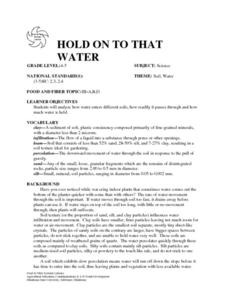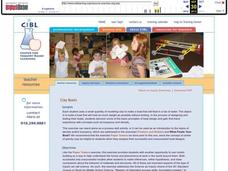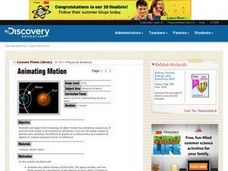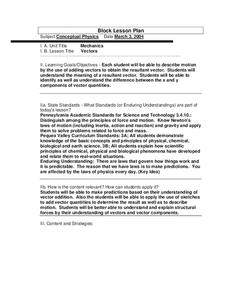Curated OER
HOLD ON TO THAT
Students will analyze how water enters different soils, how readily it passes through and how much water is held.1. Materials needed for the activity are; pint of clay, pint of sand, pint of loam, newspaper,
three frozen fruit juice...
Curated OER
Clay Boats
Seventh graders are given the opportunity to use model-building as a way to help comprehend the forces and phenomena at work in the world around them. They use both successful and unsuccessful models to make inferences, refine...
Curated OER
What Floats Your Boat?
Students discover the Archimedes principle through a buoyancy experiment. They measure the water displacement of a lump a clay which is denser than water then reshape the clay into a bowl which floats but displaces more water.
Curated OER
Animating Motion
Students apply what they recall about objects in motion by animati ng sequences of pictures that model a set of physical conditions. They animate the orbital motions of the Earth, the space shuttle, and the Moon based on calculations of...
Curated OER
Doing More In Less
Young scholars watch segments of a NASA program called "Doing More In Less". In groups, they examine the concept of human exploration and how NASA has contributed to specific research. They are introduced to new vocabulary and answer...
Curated OER
Vectors
Students describe motion by the use of adding vectors. They identify the difference between the x and y components of vector quantities. Students are given the Paper Bridge Building handout and the instructions as to where to perform...
Curated OER
Timing An X-ray Pulsar
Students use X-ray data to identify an object as a rotating neutron star, and determine its period of rotation. They use XTE observations of the Crab Pulsar to determine the period of the light intensity, interpret this period as the...
Curated OER
Mass and Weight
Learners explore the science topics of mass and weight. In this mass and weight lesson, students determine the difference between mass and weight as they discuss the definitions and the application the definitions.
Curated OER
Newton's Third Law of Motion
Seventh graders are introduced to Newton's Third Law of Motion. In this physics lesson students examine the concept of thrust as one of the forces acting on aircraft.
Curated OER
THE FLIGHT PLATFORM
Students examine forces that effect flight. In this flight instructional activity students answer questions that are asked of them and the ones that they ask themselves.
Curated OER
Lives of Stars
Pupils explain in their own words how stars are formed. In this space science lesson plan, students summarize the life cycle of stars. They draw diagrams and label the step of the cycle they represent.
Curated OER
Look Mom, No Wings!
Students explain how drag, weight, lift and thrust work together to make something fly. For this physics lesson, students measure their jump height and record data on the table. They reason out why they can't remain airborne for long.
Curated OER
Bottle Rocket Lesson
Students design a rocket that stays on air for the longest period of time. For this physics lesson, students research the function of different rocket components. They test their design and make necessary modifications.
Curated OER
Scientific Inquiry: Periodic Motion
Students construct their own pendulum. In this physics lesson, students design an experiment to find the factors affecting its period. They formulate a conclusion based on experimental data.
Curated OER
Projectile Motion: Hit the Army Men
Pupils predict the correct projectile launcher angle to hit the target. In this physics lesson, students record data on a spreadsheet. They curve their data and calculate the place of ball impact at an angle.
Other popular searches
- Gravity Tides
- Force of Gravity
- Center of Gravity
- Gravity Science Experiment
- Science Project Gravity
- Law of Gravity
- Friction and Gravity
- Planet Orbit Gravity
- Force and Gravity
- Specific Gravity
- Elementary Science Gravity
- Center of Gravity Activities
















